Site menu:
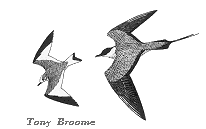
October 2018 Newsletter
Wetland Bird Survey 2016/17.
Wirral Wader Festival 2018.
Colour Ring Report.
September Bird News.
Forthcoming Events.
Latest Newsletter.
Wetland Bird Survey 2016/17
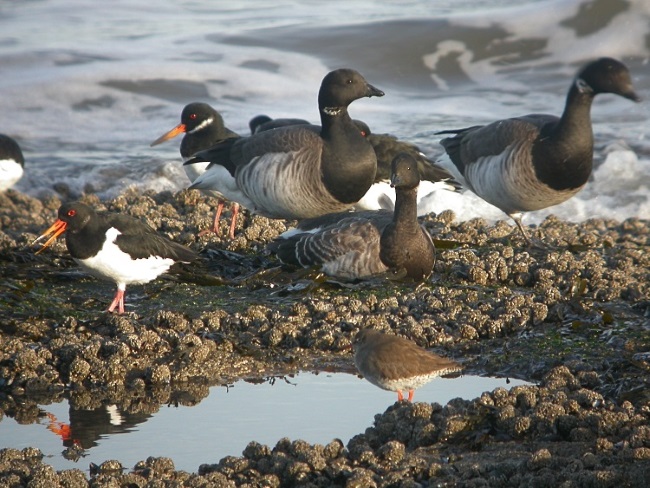
Both the National and Dee Estuary Wetland Bird Survey (WeBS) Reports
have been published for 2016/17.
The National data can be accessed here https://app.bto.org/webs-reporting/ ; it is presented both by Site and by Species and records go back for several decades. There is also a written report which has many fascinating articles, here is the list for 2016/17:

Below are a few tidbits from the Reports which I hope you find interesting:
North-west Estuaries Super-site

This map, from page 12 of the national Report, really brings home the importance of the group of estuaries in North-west England with the Duddon Estuary in the north, then Morecambe Bay, Ribble, Alt and Mersey with the Dee estuary in the south. This super-site typically hold over 500,000 birds in the winter, similar to that other super-site The Wash and north Norfolk coast, and is particularly important in cold winters when North Sea coasts are frozen, as in March 2018.
Good Wildfowl Numbers
Despite 2016/17 being mild and dry good numbers of Wildfowl were present both on the Dee Estuary and Nationally, presumably much colder weather on the continent pushed them west. On the Dee Estuary Pink-footed Geese reached a landmark 10,564 in March with large flocks on the marshes and small flocks becoming wide spread in fields around the estuary, it was only 2008/09 when the max WeBS count was just 329! There was also a record number of Brent Geese with 402 in November after several years when numbers were stuck around 250. The max Wigeon count was 7,677 in December, the second ever highest WeBS count here, there were also good numbers of Pintail, Shelduck and Teal. The Dee Estuary, or more accurately the Liverpool Bay area off the estuary and North Wirral, had the highest counts of Common Scoters in the country with massive numbers in 2016 including 36,000 in February and 40,000 in October.
Barnacle Geese

On
the Dee Estuary there is a small resident population of Barnacle Geese
which breed at Caldy Wildfowl Collection, usually around 12 birds. But
occasionally we get ones and twos, or even small flocks, elsewhere on
the estuary and in the winter of 2016/17 between 22 and 40 were regular
at Connah's Quay Reserve and nearby sites. A long time ago, and we are
talking about 150 years here, the Dee Estuary was known for it's
wintering Barnacle Geese. So are these birds we are currently seeing
the long awaited return of wild birds? Sadly the answer seems that it
is very unlikely.
Up until some recent work, reported in the 2016-17 WeBS Report, we thought there was a real possibility that some birds were wild as there was an increasing number of Barnacle Geese wintering on the Dyfi Estuary, not too far from the Dee.
I quote from the article Where do the Dyfi Barnacle Geese
breed?:
"The Dyfi Estuary in
mid-Wales is known as a long-standing haunt of the Greenland
White-fronted Goose. From the 1990s Barnacle Geese began over-wintering
at the Dyfi. It seemed likely that this flock were from the Greenland
population of Barnacle Goose, and had followed White-fronted Geese to
the site."
With numbers rising to between 300 and
400 on the
Dyfi over the past
few winters, and approaching the Nationally Important Threshold, it was
decided to try and determine the origin of these birds through colour
ringing. It soon became clear that these birds were feral and bred in
the Lake District. As well as spotting ringed birds there was
also
good correlation of numbers between the two sites, and of departure and
arrival times. Perhaps a disappointing outcome but still a fascinating
migration, if somewhat shorter than flying from Greenland to Islay. As
well as these birds there are feral Barnacle Geese both breeding and
wintering in nearby Lancashire, probably at least 100 birds, and it
seems likely that some of these wander south to the Dee Estuary. So the
conclusion from all this is that any Barnacle Goose seen in our area is
almost certainly from the feral population.
Waders
Given the high wildfowl numbers it's something of a surprise that wader numbers were relatively low. But Oystercatchers bounced back to close to the five year average, with 20,857, after very low counts the previous year. At 11,158 Lapwing numbers were the highest since 1994. Knot numbers were disappointing with a max of only 8,481* but nationally Knot counts have been fairly steady and for 2016/17 include a remarkable 205,161 counted on the Wash in October 2016, a record high for that site.
* Knot numbers for the Dee high tide WeBS counts do tend to be under estimated mainly due to disturbance at high tide roosts, particularly Hoylake. It doesn't help that counts take place on a Sunday when the beaches are busy with people.
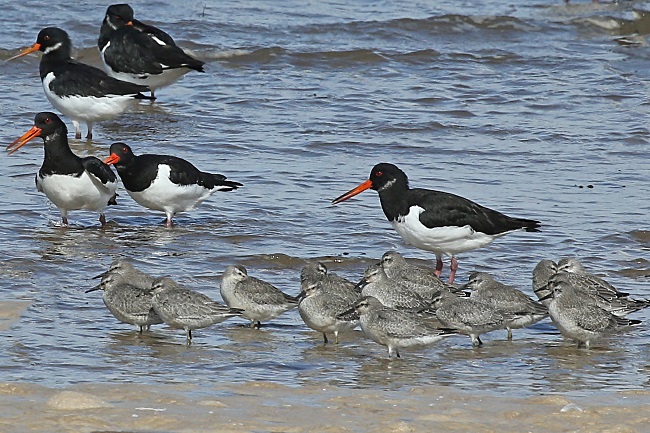
References
1.Wetland Bird Survey Annual Report (2016/17) - available on-line: http://www.bto.org/volunteer-surveys/webs/publications/webs-annual-report(also historical data from the same source).
2. Dee Estuary and North Wirral Foreshore WeBS Annual Report 2016/2017, compiled by Neil Friswell and approved by Colin E. Wells (Dee Estuary WeBS Coordinator).
3. Glen Morris, Deeside Naturalists
Society Bird Reports, 2016 and 2017 (Available on-line at
http://www.deenats.org.uk/index.html).
Top of Page

Click links here:
For Sunset walk to Hilbre - westkirbyhoylakemeolsparks@wirral.gov.uk
For Wildlife walk at Red Rocks - www.cheshirewildlifetrust.org.uk/events/2018-10-28-red-rocks-afternoon-walk-wirral-wader-festival
For latest News on the Wirral Wader Festival - wirralwaderfestival.blogspot.com/
Top of Page
Colour Ring Report - Knot Special

September 22nd marked the anniversary of the first catch of Knots at
Altcar (just south of Formby Point) which were ringed with an Orange
flag over a pale blue ring (usually shortened to OflagP). 519 Knots
were ringed, since then there have been a remarkable 2,440 readings of
those Oflags including 1,199 readings here on the Dee estuary and north
Wirral shore.
As the years progress the continuing reading of these rings will become more and more important in order to gain a better understanding of their movements including the different migration strategies of individual birds, as well as their longevity, breeding success, survival rates etc. In the meantime the year they have been studied so far has revealed some fascinating movements. We saw a definite movement of feeding birds with Formby/Crosby used almost exclusively in October but by December nearly all had moved to Thurstaston. By February and March far more birds were feeding at West Kirby but with Spring the birds returned to Formby/Crosby. There was then an obvious northward movement and birds were seen around Morecambe Bay, north-east England then both the Outer Hebrides and the Orkneys. In May 82 Oflagged Knot were recorded in south-west Iceland which is used as a staging site before they move on to Greenland and northern Canada to breed.
Many immature birds don't make this northward journey. Some years they spend the summer in the Ribble and Alt area but in 2018 they dispersed around the Irish Sea with Oflagged birds spotted at several locations on the east coast of Ireland as well as Walney Island by Morecambe Bay.
The adults had started returning by
mid-July and we started seeing
Oflagged birds at Formby and Crosby. There were rumours of a bad
breeding season but that turned out to be false (see 'Have
Arctic-breeding Waders had a poor Breeding Season?') with
many juveniles arriving through August. Although we did see a few Knot
on the Dee estuary/North Wirral we didn't see the first OfP until
September 21st, and, up until the end of September, we've seen a
pitiful three Oflagged birds compared to several hundreds over at
Formby/Crosby! But small numbers of Knot over here in autumn is normal,
and we won't see the big numbers until November. Other returning
Oflagged Knots have turned up on the Waddensee, a major moulting site
for this species, and at both Snettisham and Titchwell on the
Wash.
Below is a history of four OfP Knots:
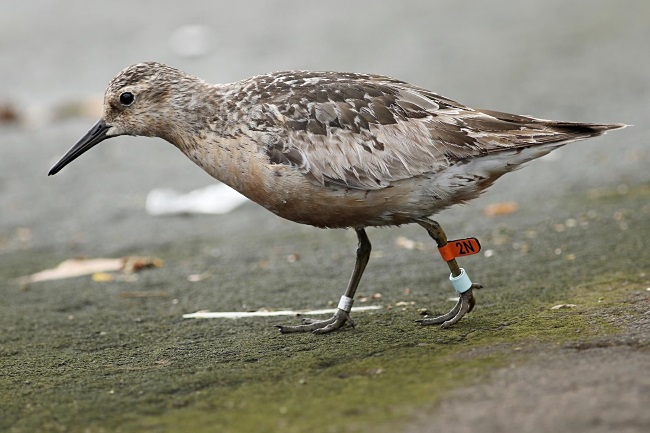
Orange flag (2N) over P - ringed at Altcar on September 22nd 2017.
Recorded:
Crosby on October 13th 2017.
Thurstaston on December 12th 2017, January 23rd and 26th 2018.
West Kirby on February 21st, 27th and 28th.
Sao Miguel, Azores, on September 22nd 2018.
The record on the Azores was totally
unexpected and is the first BTO
ringed Knot recorded there. We can only speculate how it arrived on the
Azores with the few Knot that find their way there normally
being the Rufa
sub-species
which migrate between the Canadian Arctic and South America. I quote
Knot expert Jim Wilson (who is also coordinating many of the colour
ringed Knot projects, including OfPs) - "One scenario is that it
had migrated South into the wrong flyway - west Atlantic Flyway. We
have 3 records of knots staging in Iceland - turning up in the Autumn
on the major staging sites at Mingan at the mouth of the St Lawrence,
Canada. If it then corrected its course to the correct course, SW, then
it would head out over the Atlantic and could land up in the Azores. Of
course it could have simply got blown out over the Atlantic on
its route between Greenland/Iceland and Europe."
Orange flag (ET) over P
- ringed at Altcar on September 22nd 2017.
Recorded:
Thurstaston on December 21st 2017.
Skogarnes in SW Iceland between May 15th and 19th 2018.
Blithfield Reservoir, Staffordshire, on August 18th and 19th 2018.
Any inland Knot is unusual and this one is the first BTO ringed knot to
be recorded in Staffordshire.
Orange flag (1M) over P
- ringed at Altcar on September 22nd 2017.
Recorded:
Crosby on September 30th 2017.
Formby Point on October 6th 2017.
Thurstaston on December 22nd 2017.
Findhorn Bay, NE Scotland, on February 22nd 2018.
North Ronaldsay, Orkney, on May 1st 2018.
Crosby on September 4th 2018.
Caldy on September 21st 2018.
This was the first Oflagged Knot recorded on the Dee Estuary after the
breeding season,
Orange flag (0Y) over P
- ringed at Altcar on September 22nd 2017.
Recorded:
Caldy from September 28th to October 12th.
Leighton Moss from April 25th to May 1st.
Lambastadir, SW Iceland, on May 13th and 15th.
Formby Point from July 27th to August 3rd.
Crosby on August 6th.
Caldy on September 24th and 27th.
There were no records of this bird over this last winter, as it turned
up at
Leighton Moss in spring perhaps it spent the winter on Morecambe Bay.
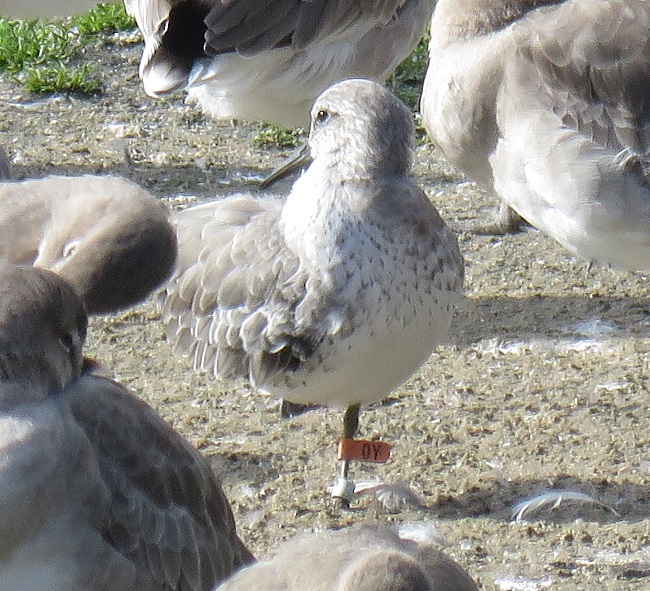
Many thanks to the 'Knot Oflag Team' and others for all the records, specially Jim Wilson, Steve Hinde, Peter Knight, Rose Maciewicz and Richard du Feu - and even more thanks to the ringing team which have now ringed around 1000 Knot at Altcar which will keep we Colour Ring enthusiasts busy for a few years!
Several other colour-ringed species were observed during September and these will be reported in the next newsletter.
Richard Smith.
Top of PageSeptember Bird News
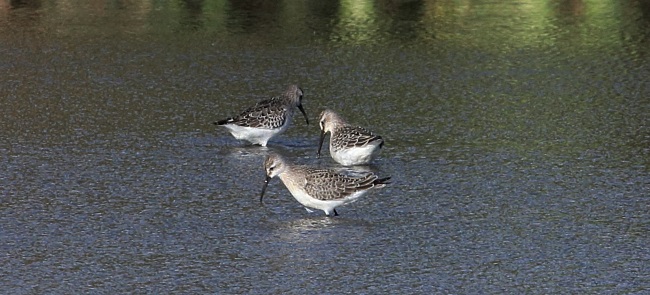
Single Leach's Petrels were observed at Hilbre and Hoylake earlier in the month but it was overnight gales on the night of the 20th, and during the 21st, that brought good numbers and they were seen from New Brighton to Hilbre, max count 15 at the latter site. They were still passing through the following day and Hilbre again had the highest count of seven. In addition at least a couple of Long-tailed Skuas were seen together withseveral Grey Phalaropes (up to 5?), Great Skuas, Arctic Skuas, Manx Shearwaters, a Sabine's Gull and a Roseate Tern.

A juvenile Pallid Harrier was spotted over the marshes between Parkgate and Burton on the 4th and was recorded up to the 6th and again on the 16th and 17th. Two Spotted Crakes were at Shotton whilst the one at Burton Mere Wetlands showed really well from the Reception Hide. A Chough was an excellent record for Hilbre on the 16th.
Marsh Harriers were recorded daily, they seemed to have switched their roost site from Neston reedbed to Parkgate, the highest definite count was eight but I wouldn't be surprised that total numbers are already in double figures. Up to four Spoonbills and eight Great Egrets have been at Burton Mere Wetlands.
During glorious weather at the end of the month Pink-footed Geese were flying into the estuary by the hundreds, a fantastic sight for those up early enough to see it.

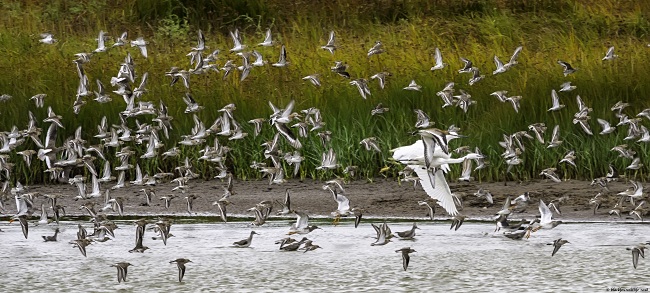
Many thanks go to Jeremy Bradshaw, Mark Woodhead, Charles Farnell, David Haigh, Steve Hinde, Matt Thomas, Chris Butterworth, David Leeming, Alan Hitchmough, Steve Williams, Derek Bates, Allan Conlin, Karen Leeming, Frank Burns, David Thompson, Richard Beckett, David Small, Steve Round, Tim Kinch, Elliot Montieth, Les Hall, Roy Lowry, Mal Seargant, Colin Schofield, Alan Irving, Mark Garner, Bill Owens, Damian Waters, Prudence Quayle, Mark Gibson, Phil Boardman, Jeff Cohen, Graham Connolly, Chris Wilding, Paul Lee, Carole Killikelly, Craig Bell, Dave Edwards, Richard Payne, Richard Steel, Richard Whitby, Richard Speechley, Sheila Saunders, Tim Wilcox, Adrian Morgan, Pam Livesly, Sue Roebuck, Gail Wilson, Charlie Lowe, Linda Platt, Manu Santa-Cruz, Gkyn Thursfield, Gill Lewis, Lyn Robinson, the Lighthouse and Wirral Birding Blog, the Dee Estuary Wardens and the Hilbre Bird Observatory for their sightings during September. All sightings are gratefully received.
Top of Page
What to expect in October
Prolonged north-westerly gales, especially early in the month, will result in the usual Leach's Petrels, selection of Skuas, Grey Phalaropes and Sabine's Gulls - although numbers are likely to be smaller than during September gales. Both wader and wildfowl numbers will increase and on high tides these can be a fantastic sight.
On the marshes there will be plenty of Marsh Harriers and Short-eared Owls, hopefully both in double figures, with smaller numbers of Hen Harriers.
We are more or less guaranteed a good selection of rarities this month - recent years have included Melodious Warbler, Yellow-browed Warbler, Pectoral Sandpiper, Rose-coloured Starling, Olive-backed Pipit, Richard's Pipit, Slavonian Grebe.....................

Top of Page
Forthcoming Events
October Highest Spring Tides (Liverpool)
Also see Tides page.
9th October, 12.00hrs (BST),
9.8m.
10th October, 12.39hrs (BST), 9.8m.
11th October, 13.16hrs (BST), 9.7m.
Forthcoming Events
Organised by the Wirral Ranger Service , Flintshire Countryside Service and the RSPB (Dee Estuary): All these events and walks have bird interest, even those not advertised specifically for birdwatching. No need to book for these events unless specified - please check below.
Sunday 14th October - RSPB Raptorwatch at Parkgate.
1pm-dusk, Price: Free.
Join us for a chance to see up to seven different birds of prey including peregrine and merlin, plus two types of owl that all make their home on the RSPB Dee Estuary nature reserve. With its panoramic views of the saltmarsh, Parkgate is one of the best places to watch for these birds hunting.
Stick around until dusk for a chance to see the graceful and endangered hen harriers flying into roost for the night on the marsh close to the Old Baths car park, and maybe a ghostly barn owl emerging to hunt. No booking required, come along any time between 1pm and sunset.
Dress appropriately for the weather and don't forget your binoculars! Public toilets and various pubs and cafes are situated close by along Parkgate promenade.
Saturday 27th October, Deeside Naturalists' Society Open Day at Connah's Quay Nature Reserve.
10am to 3pm. High Water 9.5m at 13.35hrs.
Free Admission, Tea and Coffee available at the Field Studies Centre.
For directions see http://www.deenats.org.uk/findus.html.
Saturday 27th and Sunday 28th October - WIRRAL WADER FESTIVAL
Events include high tide birdwatches at Hoylake and West Kirby on both days and a sunset walk to Hilbre on the Saturday. See details above - click here.
Sunday 11th November - Raptorwatch at Parkgate.
1pm-dusk, Price: Free.
Join us for a chance to see up to seven different birds of prey including peregrine and merlin, plus two types of owl that all make their home on the RSPB Dee Estuary nature reserve. With its panoramic views of the saltmarsh, Parkgate is one of the best places to watch for these birds hunting.
Stick around until dusk for a chance to see the graceful and endangered hen harriers flying into roost for the night on the marsh close to the Old Baths car park, and maybe a ghostly barn owl emerging to hunt. No booking required, come along any time between 1pm and sunset.
Dress appropriately for the weather and don't forget your binoculars! Public toilets and various pubs and cafes are situated close by along Parkgate promenade.